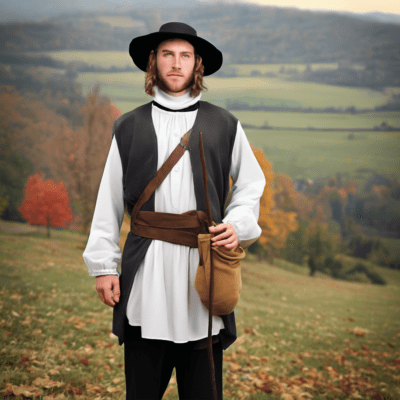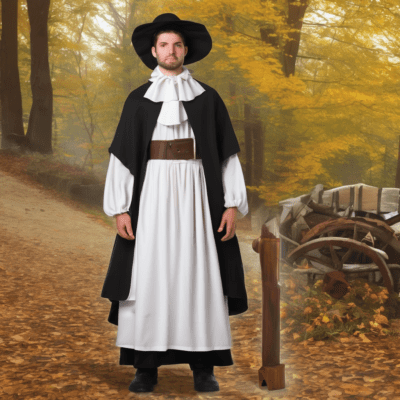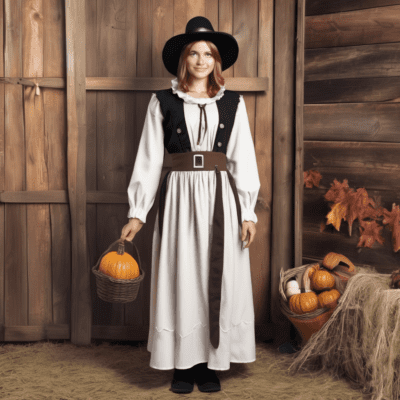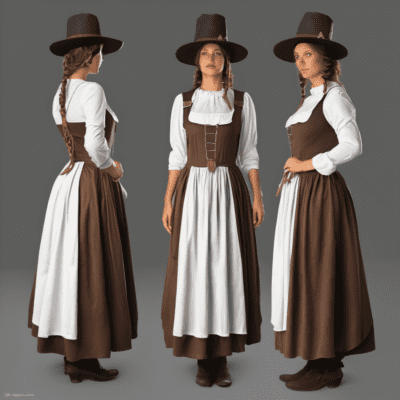The Evolution of Pilgrim Costumes
For centuries, the pilgrim costume has been a staple in historical reenactments and educational dramatizations. Initially, the costume was representative of the simple clothing worn by the real pilgrims of the 17th century. This often included black wide-brimmed hats, fabric belt, buckled shoes, fabric-covered buttons at center front, and dark-coloured clothing with white collared shirts.
However, as time passed, the portrayal of this Renaissance costume began to evolve. The representation of the pilgrims in popular culture shifted from the realistic portrayal of the 17th-century Puritans to a more symbolic representation of the pilgrim’s voyage. The buckles became larger, the classic pilgrim hats more iconic, and the entire outfit a more dramatic representation of the time.
Today, the correct pilgrim costume has become symbolic, more than realistic. Its evolution is a reflection of the way society has chosen to remember and portray this period in history. The outfit has been simplified, stylized, and transformed into an easily recognizable symbol of early American colonization.



Scott’s Influence on Pilgrim Costume Design
Sir Walter Scott, a prominent Scottish novelist and poet of the early 19th century, had a significant influence on the design and popularization of historical costumes, including Pilgrim attire. While Scott’s literary works primarily focused on medieval and Renaissance settings rather than the Pilgrim era specifically, his romanticized depictions of historical periods played a role in shaping the public’s perception of historical fashion.
- Romanticized Imagery: Scott’s vivid descriptions of historical settings, characters, and clothing in novels such as “Ivanhoe” and “The Lady of the Lake” helped romanticize the past in the public imagination. His romantic portrayal of medieval and Renaissance fashion may have indirectly influenced costume designers to draw inspiration from historical periods, including the Pilgrim era.
- Revival of Interest: Scott’s novels sparked a revival of interest in historical themes and aesthetics during the 19th century, known as the Romantic movement. This revivalism extended to fashion, with people increasingly drawn to historical costumes for theatrical productions, masquerade balls, and other social events.
- Costume Drama: The popularity of Scott’s novels also contributed to the rise of costume dramas in theater and later in film and television. Productions featuring elaborate historical costumes became a staple of entertainment, further embedding historical fashion in popular culture.
- Visual Representation: While Scott’s novels did not specifically depict Pilgrim attire, the visual representations of historical costumes in adaptations of his works and other historical dramas may have influenced costume designers to incorporate similar elements into Pilgrim costume designs. This could include aspects such as modest silhouettes, simple color palettes, and traditional accessories.
- Cultural Impact: Scott’s influence extended beyond literature to influence broader cultural trends, including fashion. As his novels gained popularity, so did the interest in historical themes and aesthetics, shaping the design choices of costume designers and influencing the public’s perception of historical clothing.
While Scott’s direct influence on Pilgrim’s basic costume design may be indirect and tangential, his broader impact on the romanticization of historical periods and the popularization of historical fashion likely contributed to the ongoing fascination with Pilgrim attire and its portrayal in various forms of media and entertainment.



The Role of Pilgrim Costumes in Educational Settings
Pilgrim costumes have a vital place in schools as they assist in teaching students about the early history of America. The costumes play a significant role in creating a visual understanding and connection to the past. They help to bring history to life, allowing young people to gain a deeper understanding of the pilgrims’ journey and struggles.
Furthermore, these costumes are used during school plays, Thanksgiving celebrations, and history lessons. They help in the depiction of important historical events and figures, providing students with a hands-on and interactive history lesson.
While some critics argue that the costumes oversimplify history, teachers and educators maintain that the use of costumes, props and dramatisation is a valuable teaching tool, engaging the interest of students and making history feel more accessible and relevant to them.
The Impact of Theatre and Film on Pilgrim Costumes
Theatre and film have played a pivotal role in popularising the iconic image of the pilgrim costume. On stage and screen, the pilgrim costumes have been exaggerated and dramatised for visual impact, which has led to the iconic image we recognise today.
Actors dressed in the grandiose and exaggerated costumes designed by artists like Scott help to breathe life into history. They captivate the audience’s attention and create memorable visuals that stay ingrained in the minds of the viewers.
These portrayals have influenced the popular perception of pilgrims, turning the pilgrim costume into a symbol rather than an accurate representation of historical clothing. Despite the historical inaccuracies, the modern pilgrim costume has become deeply embedded in America’s cultural memory, largely due to its depiction in theatre and film.



Distinctive Characteristics of Pilgrim Costume
The Pilgrim costume is known for its distinctive and modest appearance, reflecting the clothing worn by the Pilgrims who arrived in America aboard the Mayflower in 1620. Here are some of its key characteristics:
- Black and White Color Scheme: Pilgrim costumes typically feature a simple color palette of black and white. Men often wear black pants, black jackets, and white collared shirts, while women wear long black dresses with white collars and cuffs.
- Bonnet or Hat: Women often wear a white bonnet or cap tied under the chin, while men may wear wide-brimmed hats, often black in color.
- Aprons: Women’s costumes often include a white apron worn over the dress, adding to the modest and practical appearance.
- Simple Silhouettes: Both men’s and women’s costumes feature simple, straight silhouettes without much embellishment or ornamentation. The clothing is designed for functionality and practicality rather than fashion.
- Modesty: Pilgrim clothing reflects the modest values of the time period, with high necklines, long sleeves, and full-length skirts or pants.
- Lack of Decoration: Pilgrim costumes typically lack decorative elements such as embroidery, lace, or frills. Instead, the focus is on practicality and simplicity.
- Heavy Fabrics: Traditional Pilgrim costumes are often made from heavy, durable fabrics such as wool or linen, suitable for the harsh conditions of the time period.
- Buckles and Buttons: Some Pilgrim costumes include buckles or buttons as functional closures on jackets, shoes, or hats, adding a touch of detail to an otherwise simple ensemble.
Overall, the Pilgrim costume is characterized by its simplicity, modesty, and functionality, reflecting the values and lifestyle of the early settlers in America.



Tips for Choosing The Right Pilgrim Costume
When choosing the right Pilgrim costume, consider these tips to ensure authenticity and comfort:
- Research: Start by researching Pilgrim clothing from reliable historical sources or reputable costume guides. Understanding the typical styles and components of Pilgrim attire will help you make informed choices.
- Authenticity: Aim for authenticity in your costume selection. Look for costumes that closely resemble historical Pilgrim clothing in terms of color, fabric, silhouette, and details.
- Quality: Opt for high-quality costumes made from durable fabrics. This ensures that your costume will withstand wear and tear, maintaining its appearance throughout events or performances.
- Fit: Choose a costume that fits well and allows for comfortable movement. Avoid costumes that are too tight or restrictive, as they can be uncomfortable to wear for extended periods.
- Accessorize: Consider adding authentic accessories to enhance the realism of your Pilgrim costume. This may include bonnets, hats, aprons, buckles, and shoes that complement the overall look.
- Layering: If the climate allows, consider layering clothing to achieve a more authentic Pilgrim appearance. For example, women can wear a chemise or undergarment beneath their dress, while men can layer a shirt under their jacket.
- Customization: If purchasing a pre-made costume, consider customizing it to better suit your preferences or historical accuracy. Adding or removing certain elements can help tailor the costume to your specific needs.
- Try It On: Whenever possible, try on the costume before making a final decision. This allows you to assess the fit, comfort, and overall appearance to ensure it meets your expectations.
- Budget: Set a budget for your Pilgrim costume and explore various options within your price range. You can find costumes ranging from basic to more elaborate designs, so choose one that aligns with your budget and needs.
- Feedback: If you’re participating in a group event or performance, seek feedback from organizers or fellow participants to ensure your costume aligns with the overall theme and standards of the event.





